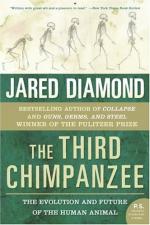
|
| Name: _________________________ | Period: ___________________ |
This test consists of 15 multiple choice questions and 5 short answer questions.
Multiple Choice Questions
1. In nearly every historic case, what happened to the native people following first contact?
(a) They overpower the other culture.
(b) They suffered dramatically.
(c) They became more technologically developed.
(d) They suffer less.
2. How could one describe the factors involved in the formula?
(a) Exact.
(b) Objective.
(c) Incorrect.
(d) Estimated.
3. Does the epilogue offer a particularly hopeful look toward the future?
(a) In some parts of the world.
(b) No.
(c) Only for powerful nations.
(d) Yes.
4. By what do many suggest that today's societal ills could be eliminated?
(a) Look to the past as a way to learn from previous mistakes.
(b) Enjoy the present, since there is not much hope in the future.
(c) Working toward a better future and an era of peace and environmental purity.
(d) A return to a fondly remembered era of peace and environmental purity.
5. Are smoking, drinking, and drug use universal human traits?
(a) Only in the Western world.
(b) Only in Third World countries.
(c) No.
(d) Yes.
6. Is genocide a common occurrence in human history?
(a) Only by Western cultures.
(b) In some cultures.
(c) No.
(d) Yes.
7. How were these peoples referred?
(a) The Clovis culture.
(b) The Folsom culture.
(c) The Folter culture.
(d) The Clover culture.
8. What is a prevalent habit among modern peoples of all time?
(a) Look to toward the future and imagine the turmoil that will be taking place.
(b) Look to the past and imagine it as a horrible time of misunderstanding and ignorance.
(c) To look toward the future and imagine it as a sort of golden age.
(d) To look toward the distant past and imagine it as a sort of golden age where contemporaneous problems did not exist.
9. What does the author note about studies done on woodpeckers?
(a) Woodpecker traits are found only slightly in other bird species and yet all of the traits necessary to be a woodpecker have come together only once during evolution.
(b) Woodpecker traits are found plentifully in other bird species and yet all of the traits necessary to be a woodpecker have come together only once during evolution.
(c) Woodpecker traits are found plentifully in other bird species and most of the traits necessary to be a woodpecker have come together only once during evolution
(d) Woodpecker traits are only found in other bird species.
10. What did some European inhabitants of Australia argue should be carried out in Australia?
(a) Less genocide.
(b) Less assimilation.
(c) A similar genocide.
(d) More assimilation.
11. Several languages are all derived from a common root language, which is generally referred to as what?
(a) PE.
(b) PI.
(c) PA.
(d) PIE.
12. How many main motivating rationales does the text propose for the cause of genocide?
(a) Four.
(b) One.
(c) Eight.
(d) Two.
13. What kept this group of people isolated for so long?
(a) They were the only people in the Canary Islands.
(b) Inaccessible terrain and topography of the Canary Islands.
(c) They were the only people in New Guinea.
(d) Inaccessible terrain and topography of New Guinea.
14. Within about 1,000 years what had these people done?
(a) Arrived in North America.
(b) Travelled to Central America.
(c) Colonized North and South America.
(d) Gone extinct.
15. What is the result of this evidence?
(a) Several hundred "words" which are considered likely to be very similar to the original language.
(b) Several dozen "words" which are considered likely to be very similar to the original language.
(c) Several thousand "words" which are considered likely to be very similar to the original language.
(d) Several "words" which are considered likely to be very similar to the original language.
Short Answer Questions
1. How many species does the author suggest currently exist on earth?
2. What took place during this same time?
3. What do the Green Bank estimates indicate?
4. What did European settlers find when they first arrived in Tasmania?
5. What else does he do in the Epilogue?
|
This section contains 755 words (approx. 3 pages at 300 words per page) |

|




